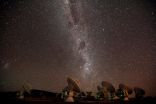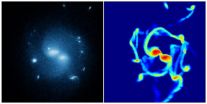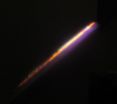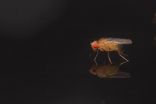(Press-News.org) Using two world-class supercomputers, the researchers were able to demonstrate the effectiveness of their approach by simulating the formation of a massive galaxy at the dawn of cosmic time. The ALMA radio telescope – which stands at an elevation of 5,000 meters in the Atacama Desert of Chile, one of the driest places on earth – was then used to forge observations of the galaxy, showing how their method improves upon previous efforts.
It is extremely difficult to gather information about galaxies at the edge of the Universe: the signals from these heavenly bodies "dilute" in the course of their billion-year journey through space toward earth, making them difficult observational targets.
Estimating how much molecular hydrogen is present in these galaxies is particularly challenging: the molecule emits almost no radiation. Nevertheless, Astrophysicists are keen to map the abundance of this element: molecular hydrogen is the fundamental building block for new stars; the more of it contained within a particular galaxy, the more stars that galaxy can form.
The carbon trick
Currently, astrophysicists make use of a trick to determine the abundance of molecular hydrogen in a galaxy: they first measure the amount of carbon monoxide – which emits far more light than molecular hydrogen – and then "convert" the carbon monoxide signal to an abundance of molecular hydrogen using a complex procedure. This method, however, is imprecise and prone to error.
"We were able to show that the radiation of neutral carbon is much better suited to observe very distant galaxies", says Dr. Padelis Papadopoulos from the University of Cardiff. "The measured values allow for a very precise estimation of how much molecular hydrogen is present." Unfortunately, the radiation from neutral carbon is almost entirely absorbed by water vapor in the earth's atmosphere, which acts similar to a pair of dark sunglasses when observing the carbon signal.
However, a new radio telescope in the Chilean Atacama Desert, the Atacama Large Millimeter/submillimeter Array (or ALMA), is designed with these limitations in mind. There, at an elevation of 5,000 meters, the conditions are so extremely dry that the telescope can easily pick up the interstellar radiation from carbon atoms.
Looking back 12 billion years into the past
"According to our calculations, ALMA can detect these distant galaxies, the signals of which have been traveling to us for more than 12 billion years", says Matteo Tomassetti, doctoral student of the University of Bonn and lead author of the publication. "Even more importantly: for the first time we are able to precisely determine how much molecular hydrogen is present in these galaxies."
The University of Bonn astrophysicist Professor Cristiano Porciani speaks of a new window to the early universe. "Our theoretical work will have an important impact on observational astronomy", he emphasizes. "It will help us to better understand the mysterious origin of the galaxies."
To carry out their work, the team was awarded resources on two world-class super-computers -- HeCTOR at the University of Edinburgh and Abel at the University of Oslo -- which were made available through a European computing cooperative known as PRACE (Partnership for Advanced Computing in Europe). The study was supported and funded by the Deutsche Forschungsgemeinschaft (DFG) within the framework of the special research area 956, as well as by the International Max Planck Research School.
INFORMATION:
Publication: M. Tomassetti, C. Porciani, E. Romano-Díaz, A. D. Ludlow, P. P. Papadopoulos: Atomic carbon as a powerful tracer of molecular gas in the high-redshift Universe: perspectives for ALMA; MNRAS Letters; doi: 10/193/mnras/slu137
Contact:
Matteo Tomassetti
Argelander-Institute for Astronomy of the University of Bonn
International Max Planck Research School
Tel.: 0228/73343, E-Mail: mtomas@astro.uni-bonn.de
Professor Cristiano Porciani
Argelander-Institute for Astronomy
Tel.: 0228/73-3664, E-Mail: porciani@astro.uni-bonn.de
CHICAGO (October 22, 2014) – New research shows vulnerable patients in the Intensive Care Unit (ICU) who received enhanced oral care from a dentist were at significantly less risk for developing a lower respiratory tract infection (LRTI), like ventilator-associated pneumonia, during their stay. The study was published in the November issue of Infection Control and Hospital Epidemiology, the journal of the Society for Healthcare Epidemiology of America (SHEA).
"Bacteria causing healthcare-associated infections often start in the oral cavity," said Fernando Bellissimo-Rodrigues, ...
CHICAGO (October 22, 2014) – New research found tracking influenza vaccination of healthcare personnel through an automated system increased vaccination compliance and reduced workload burden on human resources and occupational health staff. The study is published in the November issue of Infection Control and Hospital Epidemiology, the journal of the Society for Healthcare Epidemiology of America (SHEA).
"Mandatory vaccination programs help protect vulnerable patients, but can be tremendously time and resource dependent," said Susan Huang, MD, MPH, an author of ...
Frying is one of the world's most popular ways to prepare food — think fried chicken and french fries. Even candy bars and whole turkeys have joined the list. But before dunking your favorite food in a vat of just any old oil, consider using olive. Scientists report in ACS' Journal of Agricultural and Food Chemistry that olive oil withstands the heat of the fryer or pan better than several seed oils to yield more healthful food.
Mohamed Bouaziz and colleagues note that different oils have a range of physical, chemical and nutritional properties that can degrade ...
Drawing blood and testing it is standard practice for many medical diagnostics. As a less painful alternative, scientists are developing skin patches that could one day replace the syringe. In the ACS journal Analytical Chemistry, one team reports they have designed and successfully tested, for the first time, a small skin patch that detected malaria proteins in live mice. It could someday be adapted for use in humans to diagnose other diseases, too.
Simon R. Corrie and colleagues note that while blood is rich with molecular clues that tell a story about a person's health, ...
Action-packed science-fiction movies often feature colourful laser bolts. But what would a real laser missile look like during flight, if we could only make it out? How would it illuminate its surroundings? The answers lie in a film made at the Laser Centre of the Institute of Physical Chemistry of the Polish Academy of Sciences in cooperation with the Faculty of Physics at the University of Warsaw.
Tests of a new compact high-power laser have given researchers at the Laser Centre of the Institute of Physical Chemistry of the Polish Academy of Sciences and the Faculty ...
"We're using less expensive raw materials in smaller amounts, we have fewer production steps, and have potentially lower total energy consumption," PhD candidate Fredrik Martinsen and Professor Ursula Gibson of the Department of Physics at NTNU explain.
They recently published their technique in Scientific Reports.
Their processing technique allows them to make solar cells from silicon that is 1000 times less pure, and thus less expensive, than the current industry standard.
Glass fibers with a silicon core
The researchers' solar cells are composed of silicon fibers ...
Bright colours appear on a fruit fly's transparent wings against a dark background as a result of light refraction. Researchers from Lund University in Sweden have now demonstrated that females choose a mate based on the males' hidden wing colours.
"Our experiment shows that this newly-discovered trait is important in female choice in fruit flies, and is the first evidence that wing interference patterns have a biological signalling function between the sexes during sexual selection", said Jessica Abbott, a biologist at Lund University.
The extremely thin wings of the ...
DURHAM, N.C. -- Doctors at Duke University Hospital have developed a new collaborative model in cancer care that reduced the rates at which patients were sent to intensive care or readmitted to the hospital after discharge.
The Duke researchers shared their findings today at the Palliative Care in Oncology Symposium sponsored by the American Society of Clinical Oncology.
In the new treatment model, medical oncologists and palliative care physicians partnered in a "co-rounding" format to deliver cancer care for patients admitted to Duke University Hospital's solid tumor ...
Predicting which people will commit murder is extremely difficult, according to a new study by criminologists at The University of Texas at Dallas.
Dr. Alex Piquero, Ashbel Smith Professor of criminology and co-author of the paper, said he and his fellow researchers were motivated by the lack of scientific literature on distinguishing people who will commit homicide from those who will not.
According to the study, the similarities outweigh the differences between the two groups.
"Based on a whole slew of characteristics that we know predict and differentiate criminal ...
ITHACA, N.Y. – For the first time, a team of interdisciplinary researchers have made recordings of neurons associated with visual perception inside the poppy seed-sized brain of a jumping spider (Phidippus audax).
Video: http://www.cornell.edu/video/vision-in-jumping-spiders/s252/e552
Though neurobiologists have tried for half a century to better understand the brains of jumping spiders, no one has succeeded. The liquid in spiders' bodies is pressurized, as they move with hydraulic pressure and muscles, so they don't tolerate previous research techniques.
As ...




